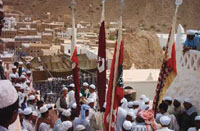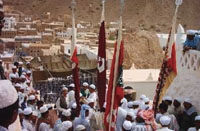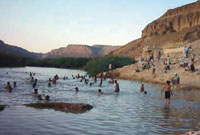
The Tomb of Prophet HoodSeeking historical secrets [Archives:2007/1066/Last Page]
July 9 2007
 |
 |
fatimafnfr@yahoo.com
Fatima Awad
First-time visitors to Yemen find themselves confronted with an unknown culture filled with new and exciting traditions. However, what may appear strange to a foreigner is quite normal in the everyday life of many Yemenis. There are many ancient traditions and customs that Yemenis have upheld to the present-day.
Visiting the graves of the prophets and righteous people is a thousand-year-old tradition in Yemen. Visiting the tomb of Prophet Hood is a special tradition amongst the sufi (mystical) inhabitants of Hadramout, as well as that of many Muslims from different countries. In the Islamic month of Sha'ban, the streets of Hadramout Al-Wadi are unusually crowded with travelers and their camels, drawing the attention of foreign visitors who are unaware of the traditions of the region.
Every year, delegations from different countries of the world, especially Muslims from Asia and East Africa, set out on a journey to visit the alleged tomb of Prophet Hood. In September 2004, the number of the visitors was said to have reached 22,000.
There are different views about such pilgrimages to gravesites. Some view these annual visits as an important tradition that should be maintained, while many Muslim scholars recognize these visits to the graves as an act of worship not sanctioned in Islam and thus a major form of heresy.
The predominate practitioners of the aforementioned tomb visitations are old men and youth, while you will find that women are completely invisible from such customs. However, the youth don't take the visits seriously, but only tag along due to curiosity. “Such a visit is only a tradition and I imitate what the old men do but I don't believe in such events,” Shukri Al-Saqqaf, 29 years old, from Hadramout noted.
Visits to the tomb take place for three to four days, usually on the eighth, ninth and tenth days of Sha'ban. Sufis pack their luggage and proceed on their journey, chanting:
“Those who visit the prophet are winners and not losers,”
“A stupid mind would prevent the visiting.”
There is a debate among some historiographers and scholars about the reality of such a visit. Many historiographers state that the grave of Prophet Hood is in Hadramout “Al-Haqaf” and that the visitation of Prophet Hood's Al- Sha'ab Village was a tradition in place both before and after the advent of Islam. Other religious scholars say that proof for such a visit is fabricated and baseless and they call the people to abandon such innovations.
“The Hood Visit and Its Abominable Actions and Abhorrence,” a study conducted by the religious sheikh (scholar) and chief of Al-Hakma committee in Hadramout, Ahmad Al-Moalem, critiques visiting the gravesite of Prophet Hood. Al-Moalem highlights some of the more blatant acts of heresy performed during these visits, such as the slaughtering of sheep for the dead righteous.
Every year the inhabitants of the village erect small markets, which contain goods to serve the needs of the visitors. Recitation of poetry and other forms of expression are used to remind the locals of the upcoming pilgrimage and encourage them to attend. The ancient village remains as it was in the past, untouched by modern hands, sustaining its uniqueness and authenticity.
The night of the 27th of the Islamic month of Rajab is when an official announcement is made regarding the upcoming visit to the grave. A team of local villagers arrange houses, called “al khadour,” to greet newly-arrived visitors.
Visitors who wish to maintain the customs of their ancestors make the trek to Al-Sha'ab on the backs of camels. In preparation for this special trip, the camels are adorned with henna and phrases inciting the remembrance of Allah are written on their sides. Riders race their camels before entering the village.
There is also a river, which all of the visitors take care to wash in before commencing their visitation rites. After bathing in the river, all the visitors pray two units of prayer in front of the stone known as the “Omer stone” because of its connection to Omer Almohdhar who was the boss of Al Aloween.
When the visitors return home, they bring with them gifts for their families, relatives, and neighbors. Gifts range from sweets, to clothes, to games and serve as a reminder of journey's past.
——
[archive-e:1066-v:15-y:2007-d:2007-07-09-p:lastpage]


